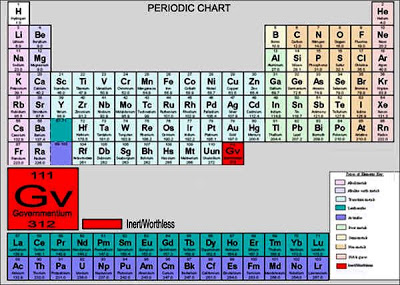Philosophy

For those who have not stayed abreast with the new Large Hadron Collider there is bad news. The new element is not a rumor but seems to have been around for a few centuries.
The new element has been named Governmentium.
Governmentium (Gv) has one neutron, 25 assistant neutrons, 88 deputy neutrons, and 198 assistant deputy neutrons, giving it an atomic mass of 312.
These 312 particles are held together by forces called morons, which are surrounded by vast quantities of lepton-like particles called peons.
Since Governmentium has no electrons, it is inert. However, it can be detected, because it impedes every reaction with which it comes into contact. A minute amount of Governmentium can cause a reaction that would normally take less than a second to take over four days to complete.
Governmentium has a normal half-life of 4 years; it does not decay, but instead undergoes a reorganization in which a portion of the assistant neutrons and deputy neutrons exchange places. In fact, Governmentium's mass will actually increase over time, since each reorganization will cause more morons to become neutrons, forming isotopes.
This characteristic of moron promotion leads some scientists to believe that governmentium is formed whenever morons reach a critical concentration. This hypothetical quantity is referred to as critical morass.
When catalyzed with money, Governmentium becomes Administratium — an element which radiates just as much energy as Governmentium since it has half as many peons but twice as many morons.
- Strange Charm: A Song About Quarks
Unless you're a physicist or a physics enthusiast, you probably have a hard time remembering the difference between subatomic particles such as quarks, electrons, protons, neutrons, leptons, gluons, hadrons, positrons, bosons and morons. Ok, fine,...
- Lady Godiva And Physics
"The time a legendary physicist was nearly killed by Lady Godiva" by Esther Inglis-Arkell Septemeber 27th, 2013 io9 Otto Frisch got a Nobel Prize for figuring out the mechanics of fission. It seemed like he would be the last person to underestimate it....
- Synthesis Of Element #117 Achieved
"Russian Physicists Synthesize New Superheavy Element 117" by Alexandra Witze April 6th, 2010 Wired Physicists have reported synthesizing element number 117, the latest in the quest to create artificial “superheavy” elements in the laboratory. A...
- Hideki Yukawa And The Pi-meson
Fascinating realm of the discovery of elementary particles. Symmetry: Michiji Konuma, Professor Emeritus, Keio University: On November 1, 1934, Hideki Yukawa began to write the first draft of an article that would earn him the 1949 Nobel Prize in Physics....
- Boron Vs Carbon
Boron: B Atomic Number: 5 Atomic Mass: 10.811 amu Melting Point: 2300.0 °C [2573.15 K, 4172.0 °F] Boiling Point: 2550.0 °C [2823.15 K, 4622.0 °F] Number of Protons/Electrons: 5 Number of Neutrons: 6 Classification: Metalloid Crystal Structure: Rhombohedral...
Philosophy
Old/New Element: "Governmentium"

For those who have not stayed abreast with the new Large Hadron Collider there is bad news. The new element is not a rumor but seems to have been around for a few centuries.
The new element has been named Governmentium.
Governmentium (Gv) has one neutron, 25 assistant neutrons, 88 deputy neutrons, and 198 assistant deputy neutrons, giving it an atomic mass of 312.
These 312 particles are held together by forces called morons, which are surrounded by vast quantities of lepton-like particles called peons.
Since Governmentium has no electrons, it is inert. However, it can be detected, because it impedes every reaction with which it comes into contact. A minute amount of Governmentium can cause a reaction that would normally take less than a second to take over four days to complete.
Governmentium has a normal half-life of 4 years; it does not decay, but instead undergoes a reorganization in which a portion of the assistant neutrons and deputy neutrons exchange places. In fact, Governmentium's mass will actually increase over time, since each reorganization will cause more morons to become neutrons, forming isotopes.
This characteristic of moron promotion leads some scientists to believe that governmentium is formed whenever morons reach a critical concentration. This hypothetical quantity is referred to as critical morass.
When catalyzed with money, Governmentium becomes Administratium — an element which radiates just as much energy as Governmentium since it has half as many peons but twice as many morons.
- Strange Charm: A Song About Quarks
Unless you're a physicist or a physics enthusiast, you probably have a hard time remembering the difference between subatomic particles such as quarks, electrons, protons, neutrons, leptons, gluons, hadrons, positrons, bosons and morons. Ok, fine,...
- Lady Godiva And Physics
"The time a legendary physicist was nearly killed by Lady Godiva" by Esther Inglis-Arkell Septemeber 27th, 2013 io9 Otto Frisch got a Nobel Prize for figuring out the mechanics of fission. It seemed like he would be the last person to underestimate it....
- Synthesis Of Element #117 Achieved
"Russian Physicists Synthesize New Superheavy Element 117" by Alexandra Witze April 6th, 2010 Wired Physicists have reported synthesizing element number 117, the latest in the quest to create artificial “superheavy” elements in the laboratory. A...
- Hideki Yukawa And The Pi-meson
Fascinating realm of the discovery of elementary particles. Symmetry: Michiji Konuma, Professor Emeritus, Keio University: On November 1, 1934, Hideki Yukawa began to write the first draft of an article that would earn him the 1949 Nobel Prize in Physics....
- Boron Vs Carbon
Boron: B Atomic Number: 5 Atomic Mass: 10.811 amu Melting Point: 2300.0 °C [2573.15 K, 4172.0 °F] Boiling Point: 2550.0 °C [2823.15 K, 4622.0 °F] Number of Protons/Electrons: 5 Number of Neutrons: 6 Classification: Metalloid Crystal Structure: Rhombohedral...
